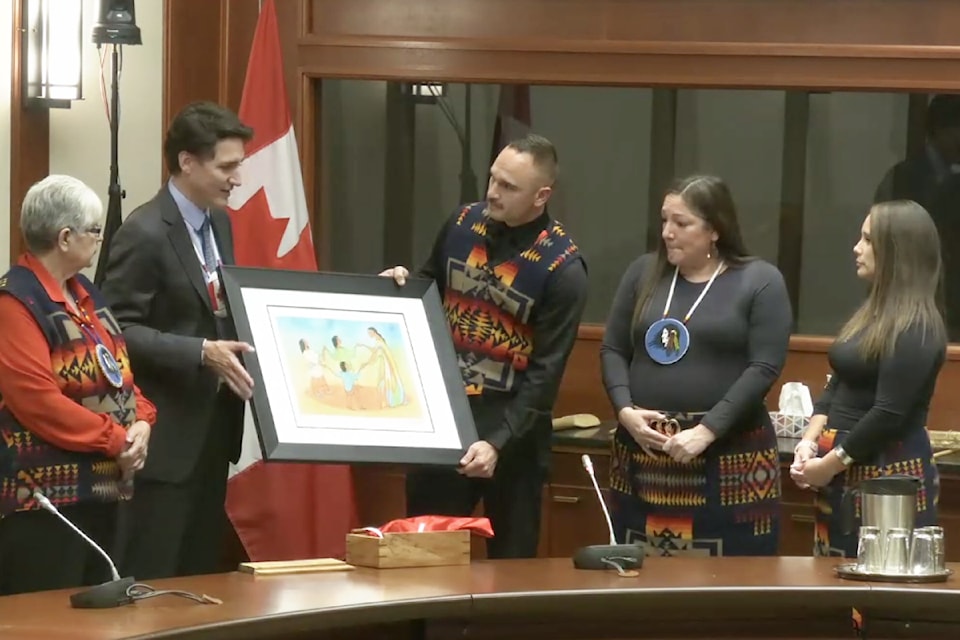Williams Lake First Nation has received a formal apology from the Canadian government for being displaced from its village lands at the west end of Williams Lake in the 1800s.
Prime Minister Justin Trudeau delivered the apology in person in Ottawa on Monday, Nov. 25 to Chief Willie Sellars, councillors Ann Louie, Shae Chelsea, Dancing Water Sandy and elder Amy Sandy.
Trudeau said an apology is a deeply important step.
"It's about taking responsibility in large part for what happened decades ago, but it is also about commitment. A commitment we make to recognize the past, recognize the errors of the past, but commit to learning from them and not just making right on them, but learning to never make them again."
The official apology was read out by Trudeau, in which he said by being displaced from the village lands by settlers, the people of WLFN lost access to a variety of resources year-round.
Canada did not protect or compensate WLFN for any of the village lands, he said.
Before the apology was read out, Chief Sellars thanked the Trudeau government for working with WLFN on its specific claims process which brought the community $135 million.
The funds have been invested into a community trust and grown to more than $150 million, he said.
"It gives us a fighting chance, levelling that playing field and allows us to do some amazing things."
Following the event, Chief Sellars sent a statement to Black Press Media.
“This was an important day for Williams Lake First Nation and other First Nations. Acknowledging that there has been mistreatment by government, and that mistreatment has caused harm to our people is meaningful. Bringing the truth to light is a critical part of reconciliation. There is still much work to be done, but WLFN will continue to do what it can to further the process of healing. We expect the governments of Canada and British Columbia to do the same. "
��������&�Բ�����;������&�Բ�����;�����Ի��&�Բ�����;����&�Բ�����;��&�Բ�����;�ٰ����Բ������ٱ��&�Բ�����;����������Dz�&�Բ�����;�Ǵ�&�Բ�����;�ٳ��&�Բ�����;����DZ��Dz���&�Բ�����;����&�Բ�����;���ɱ���&�Բ�����;�����Բ��ܲ�����,&�Բ�����;�ɳ���&�Բ�����;�հ��ܻ��&�Բ�����;��������&�Բ�����;�ɲ���&�Բ�����;�������&�Բ�����;������ǰ��ٲ��Գ�&�Բ�����;����&�Բ�����;����&�Բ�����;����&�Բ�����;�DzԱ�&�Բ�����;�Ǵ�&�Բ�����;�ٳ��&�Բ�����;���dzܲԳٰ���’s&�Բ�����;�����Բ�&�Բ�����;�����Բ��ܲ������.&�Բ�����;
Coun. Dancing Water Sandy presented Trudeau with a beaded pendant created by Secwepemc artist Lisa McAlpine depicting the Canadian Flag.
��ٳ��&�Բ�����;�����ٱ��&�Բ�����;�ٳ�&�Բ�����;�����ڳ�&�Բ�����;�ɾ��ٳ�&�Բ�����;�پ�����,”&�Բ�����;�����&�Բ�����;�ٴDZ���&�Բ�����;��.&�Բ�����;“M����&�Բ�����;��dz�&�Բ�����;�ɱ�&�Բ�����;����&�Բ�����;����&�Բ�����;���Ǵǻ�&�Բ�����;����ٳ�&�Բ�����;���Ի�&�Բ�����;����&�Բ�����;�쾱�Ի�Ա����.”&�Բ�����;
Responding, Trudeau presented Chief Sellars with a framed art piece that he said represented family and culture and a commitment to future generations.
The ceremony ended with Sellars and the other WLFN members singing and drumming the Honour Song.
�ճ���&�Բ�����;�ɾ�����&�Բ�����;���ٲ���&�Բ�����;����&�Բ�����;���ٳٲ��ɲ�&�Բ�����;�ڴǰ�&�Բ�����;��&�Բ�����;�ճܱ���岹��&�Բ�����;�𱹱�Ծ��Բ�&�Բ�����;���������Ծ��Բ�&�Բ�����;�Ǵ�&�Բ�����;���ܲ�����&�Բ�����;�䲹�Ա�,&�Բ�����;�ٳ��&�Բ�����;��dz��ܳ���Գٲ�����&�Բ�����;�����dzܳ�&�Բ�����;����.&�Բ�����;���Dz�����’s&�Բ�����;�Ѿ��������Dz�&�Բ�����;���Ի徱����&�Բ�����;���������Գپ�����&�Բ�����;������ǴDZ�.&�Բ�����;
Members of the community watched a livestream of the apology from the Elizabeth Grouse Gymnasium at Williams Lake First Nation's Sugar Cane community.
In an interview with Black Press Media, WLFN Coun. Chris Wycotte, who has been working on WLFN’s land claim for 30 years, said receiving the compensation and apology brought him a sigh of relief.
“It was a long journey, there was a lot of ups and downs,” Wycotte said, remembering how the community celebrated wins several times throughout the process only to face new obstacles.
The process to receive compensation and an apology from the federal government started off after Wycotte found records which provided documented evidence of WLFN land being illegally taken away from its people. At the time, Wycotte was doing research into the nation’s traditional land use and culture as WLFN was working on joining the British Columbia Treaty Process.
“I credit the treaty process for bringing this claim to light. If it wasn’t for us getting into the process the claim might have never been uncovered,” he said.
WLFN brought forward a land claim and was twice rejected by the federal government, but the Indian Claims Commission later ruled the nation’s case was legitimate. It was recommended the federal government negotiate a settlement with WLFN, but this did not happen.
The nation then turned to the new Specific Claims Tribunal, which agreed WLFN’s claim was legitimate. This meant negotiating a settlement was not simply a recommendation, it was legally binding. Victory was short lived, however, because the federal government brought the case to the federal court of appeal, and the decision was overturned.
In 2018, the Supreme Court brought an end to the process by reinstating the tribunal’s decision. Wycotte said this was precedent setting.
“We didn't only win for ourselves,” Wycotte said, because this was the first claim from pre-confederation which was successful.
“It was a really big win...we kicked the door down for the rest of the First Nations across Canada,” he said.
Trudeau’s apology was the final step in the settlement and Wycotte said the nation can now close the file. However, he said actions are stronger than words, and after 30 years of legal battles, he thinks WLFN deserves a stronger apology.
“I don’t think they...really have a good understanding of what they did,” Wycotte said about the federal government. He also said the apology was too little too late, as many of the elders who contributed their oral histories which were key to winning the case are no longer around to witness today’s apology.
Wycotte said he hopes these elders can be memorialized, as the successful claim means WLFN can build a stronger and healthier community for generations to come.
With files from Monica Lamb-Yorski



